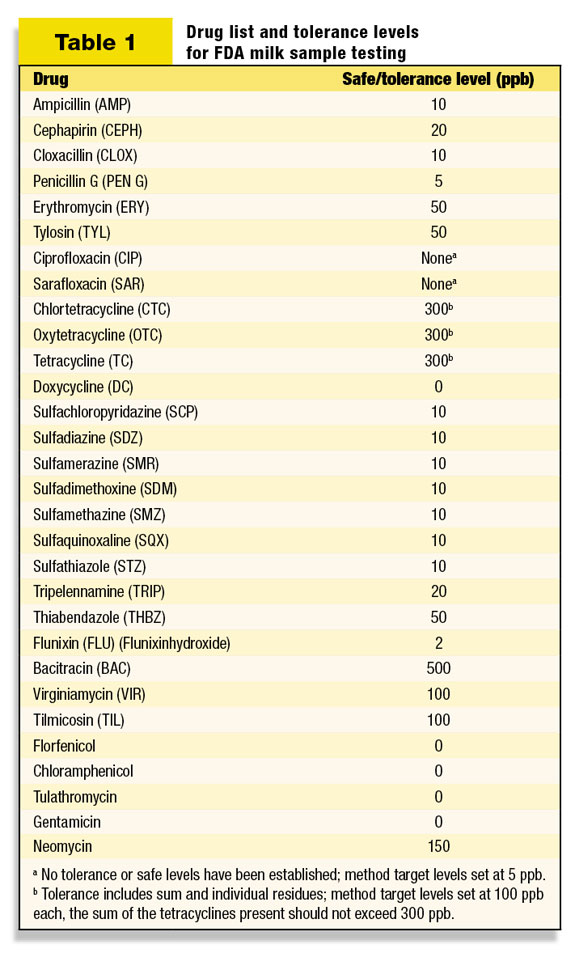The amount and level of drug residues found in tissue samples of slaughtered cattle has been well documented. Sixty-seven percent of the violations are found in cull dairy cows, and the Food and Drug Administration (FDA) would like to know if there is any link to residues in milk produced from those same cows. “We don’t think we have any kind of widespread problem, but we think that the only responsible thing we can do is to test the milk to determine just what residues there are out there,” said Deborah Cera with the Division of Compliance, Center for Veterinary Medicine, FDA.
In the coming year, the FDA will begin an assignment to collect and test milk samples from across the country, Cera announced at the Professional Dairy Producers of Wisconsin (PDPW) Dairy Policy Summit in Madison, Wisconsin, on Nov. 9.
She explained that the FDA works with the USDA and state agencies to monitor meat, poultry and milk for unapproved or unsafe drug and chemical residues. It participates in the National Conference on Interstate Milk Shipments (NCIMS) and publishes the Grade A Pasteurized Milk Ordinance (PMO) as a model ordinance for states to adopt.
Currently, the PMO requires milk from bulk milk pick-up tankers to be sampled and tested at the dairy plant for the presence of at least four of six specific beta-lactam class drugs.
“Our concern is that we’re not testing enough,” Cera said, noting there are as many as 82 classes of drugs used on dairy farms today. Some of those other classes include sulfonamide antibiotics, such as sulfadimethoxine; aminoglycoside drugs, such as gentamicin; and anti-inflammatory drugs, such as flunixin.
In fact, USDA/FSIS tissue residue data for calendar years 2005-2010 indicates that more than 50 percent of the violative drug residues in edible tissues reported in culled dairy cows are from drugs other than beta-lactam class drugs.
“The FDA is concerned that the same poor practices that lead to drug residues in tissues might also be leading to drug residues in milk, especially of non-beta lactam drugs,” Cera said.
Therefore, in November of 2010, the FDA first announced it had developed a milk sampling assignment to determine whether the concern has merit.
Initial feedback from state regulators and milk industry associations prompted the FDA to rethink its plan. After holding three listening sessions and a number of informal meetings, the agency completely revised its plan to take more of a survey approach.
Now, starting after the first of the year, FDA investigators will collect 900 samples from farms that have had tissue residue violations in cull dairy cows and 900 cohort samples from dairy farms not known to have had previous tissue residue violations.
Milk samples already collected when milk is picked up at the farm by certified bulk milk hauler/samplers will be used. FDA investigators will travel to dairy plants and provide the laboratory staff there with a list of farms with prior tissue residue history and ask if they can provide a milk sample from any of those farms.
The plant lab will be provided with a coded vial for collection. All 900 samples from farms with residue history will have the same code.
The labs will then be given a second vial with the code signifying a random cohort sample to fill with milk from another farm. These codes, the FDA says, will remove any link to the individual farms.
All samples are then shipped frozen to a private, independent third-party lab in Illinois. This lab will hold the samples for one month to further blind the connection of the sample to its farm, the lab that processed it or the state it came from, before sending the samples to one of three FDA laboratories for testing.

Milk samples will be tested for 29 antibiotics and flunixin (see Table 1 ). All residues of drugs with established tolerances will be quantitated to confirm the level of drug present.
Cera stated, “No enforcement actions will be taken in response to violative levels of residues in these samples because the purpose of the assignment is to determine if a problem exists.”
The FDA plans to use resulting data from the assignment to inform the ongoing Milk Drug Residue Risk Assessment.
Depending on the findings, the FDA and NCIMS may expand the requirements for milk testing under PMO to include additional compounds. FDA may also revise a compliance program to routinely require the testing of farm bulk milk tanks during the inspection of a farm due to a violative tissue residue.
The plan, as outlined, has been approved by the NCIMS. Prior to implementation, the FDA will hold teleconferences with the commissioners, secretaries and directors of state departments of agriculture and state milk regulatory officials. State agencies will be invited to participate in any sampling conducted in their state.
A letter will also be sent to dairy producers and laboratories explaining the assignment.
There is no specific timeline at this point, but the assignment is expected to start within the next few months and will take approximately 12 months to complete.
“In conclusion, we think that we are targeting a few members of an otherwise compliant industry,” Cera said. “The FDA continues to believe that the nation’s milk supply is safe. Efforts such as this sampling assignment will ensure that potential problems, if they exist, remain minor and are quickly mitigated by education and enforcement, as appropriate.” PD

Karen Lee
Midwest Editor
karen@progressivedairy.com





